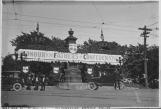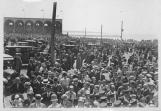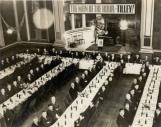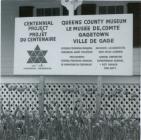14
In 1927 Canada prepared to celebrate the Diamond Anniversary of Confederation. For this sixtieth celebration, LPD Tilley, now serving in the Provincial Legislature, came to Gagetown and unveiled a plaque on the local Post Office recognizing Gagetown as the birthplace of his illustrious father. That same day, he placed a large framed photograph of Sir Samuel Leonard Tilley in the front hall of the then Dingee Hotel, his father's birthplace. The photograph has hung in the house, in the hall ever since.15
Photograph: Sir Samuel Leonard Tilleyc. 1890
Gagetown, New Brunswick, Canada
 Credits:
Credits:Gift of Leonard Percy DeWolfe Tilley, 1927
Queens County Historical Society & Museum Inc.
16
Sir Samuel Leonard Tilley may have marvelled at the celebrations of 1927. Banners and ribbons and flags paid honour to the Fathers of Confederation and the delicate and successful work of the 1860s. Crowds gathered in open parks and fair grounds to celebrate the official birthday of the nation. Dominion Day became a staple of the summer holiday season and remains so to this day. Since the originator of the term "Dominion" was Tilley, New Brunswick has always felt a special connection to the day.17
Photograph: King Square Monument, with Banner in Honor of the Fathers of Confederation1927
Saint John, New Brunswick, Canada
 Credits:
Credits:Louis Merritt Harrison Collection
New Brunswick Museum
18
Photograph: Exhibition Fair Grounds with Crowds Celebrating Confederation Diamond Jubilee1927
Saint John, New Brunswick, Canada
 Credits:
Credits:Louis Merritt Harrison Collection
New Brunswick Museum
19
In 1935 LPD Tilley was on the brink of achieving his own dream of becoming elected Premier of New Brunswick in a general election. He had been first elected as a Conservative member of the legislature in 1916 and by 1925 he was serving in the cabinet of Premier John Baxter. In 1933 Tilley became Premier when the sitting Premier, Charles Richards resigned.20
Button: Tilley for Premierc. 1930
Saint John, New Brunswick, Canada
 Credits:
Credits:Queens County Historical Society & Museum Inc.
21
Two years later in 1935, LPD Tilley faced a general election in the first test of his leadership with the full electorate. Circumstances intervened: an inability to deal with the Great Depression undermined public confidence in the government and Tilley in particular. Cruel comparisons were made with the now glittering persona of his father and the LPD Tilley government was defeated. LPD Tilley went on to become a judge on the provincial circuit court and died in 1947 at the age of 77.22
Photograph: Political Dinner for Leonard Percy DeWolfe Tilley1933-1935
Saint John, New Brunswick, Canada
 Credits:
Credits:New Brunswick Museum
23
The passing of the Hon. LPD Tilley in 1947 did little to dim the legacy of the Tilley Family and Sir Samuel Leonard Tilley in particular. In time the statue in King Square became part of the landscape and an historical icon to the founding of the country.24
Postcard: Tilley Monument, King Square, Saint John, New Brunswickc. 1960
Saint John, New Brunswick, Canada
 Credits:
Credits:New Brunswick Museum
25
As early as the 1950s it was suggested by several people in Queens County that the house in Gagetown should be restored as a museum dedicated to the life and career of Sir Samuel Leonard Tilley. Fittingly, the project gained widespread support as Canada's centennial approached and was opened to the public in June 1967.26
Photograph: Queens County Museum1967
Gagetown, New Brunswick, Canada
 Credits:
Credits:Queens County Historical Society & Museum Inc.